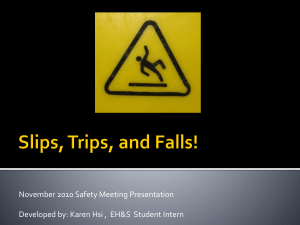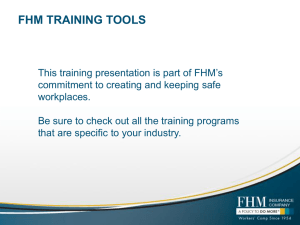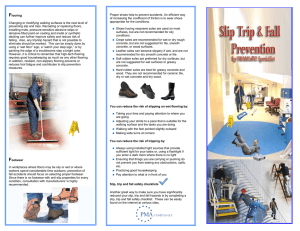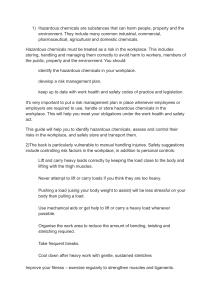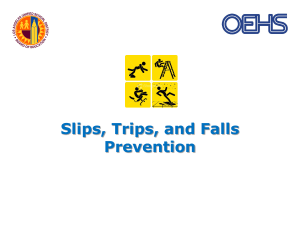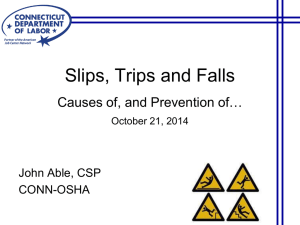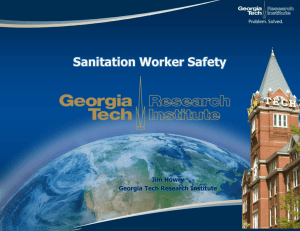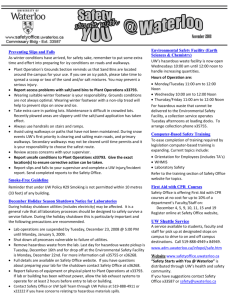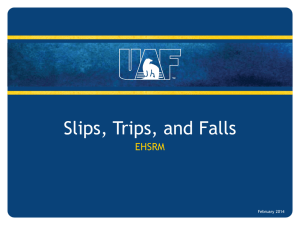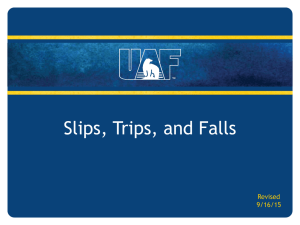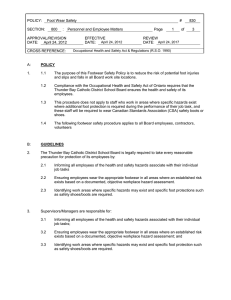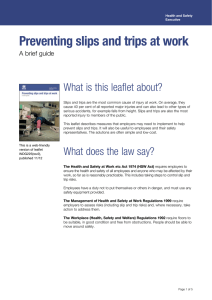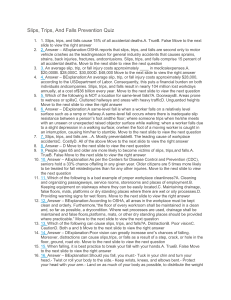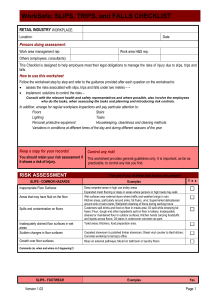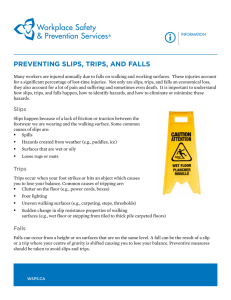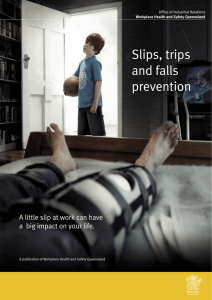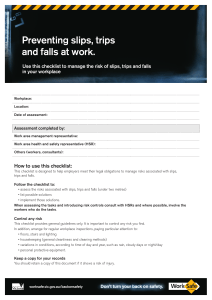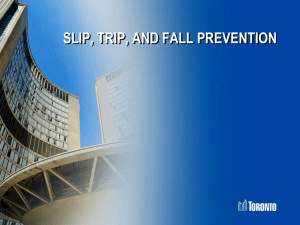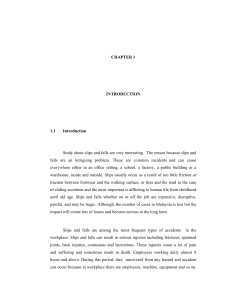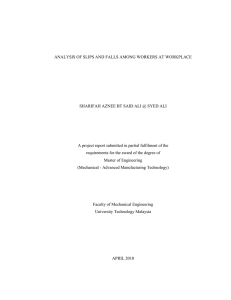a back injury can make it difficult to enjoy many hobbies or an active
advertisement
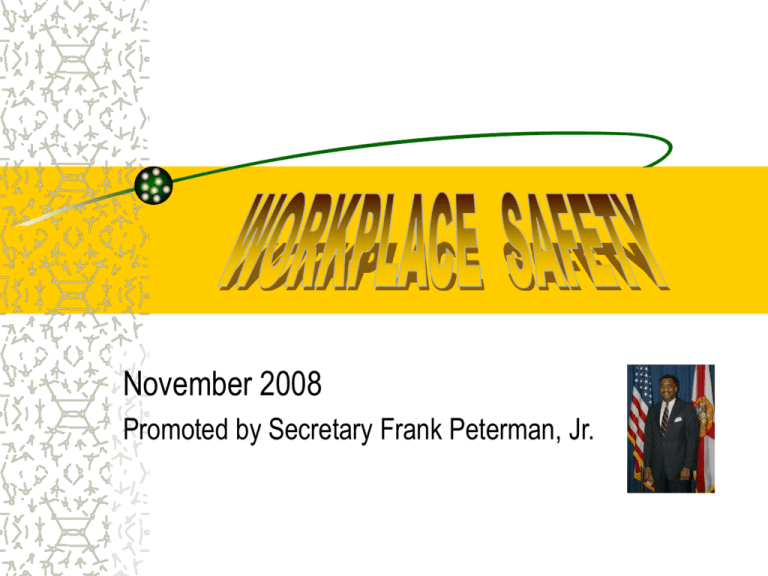
November 2008 Promoted by Secretary Frank Peterman, Jr. The goal of this campaign is to raise safety awareness by focusing on behaviors that can create hazardous situations and high-risk areas. Accident prevention helps eliminate accidents before they occur! Observe Report safety concerns Communicate Document Be aware of hazardous situations Assist co-workers when they need help. Likewise, ask for help when you need it. …with co-workers… ..so that others know what’s going on. be aware of hazardous situations! Source: The following “back injury prevention” slides are modified from The American National Red Cross Workplace Training booklet, copyright 2000. Back Injury The Cornell University Back Injury Prevention Program indicates that back injuries are the leading cause of accidents to workers under the age of 45. Back Injury Studies report that 20 % of all reported occupational injuries and illnesses are due to back injuries, with a total estimated annual cost ranging between $20 billion and $50 billion. Back injuries have severe, farreaching consequences… Pain – a back injury can be extremely painful, without any visible sign of injury Lost income – a back injury may result in loss of income, reduction in productivity, or higher insurance rates Emotional stress – a back injury may make it impossible to perform simple everyday tasks and may lead to feelings of uselessness, depression, and fear that the pain or injury will never go away ..continue.. Disability – a back injury can cause loss of mobility, making simple daily tasks, such as preparing meals or walking the dog, difficult. Some people who are injured never fully recover, resulting in long-term disability Decreased social activity – a back injury can make it difficult to enjoy many hobbies or an active lifestyle What is a back injury? In simple terms, a back injury can be defined as damage to the spine or to its supporting structures that house and protect the spinal cord. The result is an unpleasant sensation that may vary in amount and intensity, such as a dull ache or a sharp, stabbing pain. Your body depends on your back! The back supports the skull, shoulder bones, ribs, and pelvis The back houses and protects the spinal cord, which is the main line of communication linking your brain to the rest of your body If one part of the back is overloaded, other parts may suffer What causes back pain? Poor body mechanics – how the body keeps balance Weak and fatigued muscles – rob the back of support Extra weight – ten pounds of extra weight in the abdomen, equals 100 lbs of additional pressure on the discs of the spine Improper footwear – high-heeled shoes or boots can push the pelvis forward, changing the center of balance Lack of exercise – lack of exercise can decrease blood circulation and reduce muscular strength; can affect reflexes and can also slow coordination Poor posture – improper posture can lead to back problems How to reduce risk of back injury: Maintain good posture Exercise to strengthen muscles Ergonomics – defined simply as improving the “ f i t ” between your body and an activity. You can adapt your workspace, living conditions, and personal habits to reduce the bending, twisting, and excessive reaching that may cause stress on your back. Prevention tips… There are three essential requirements for maintaining a healthy back: 1) Stay healthy and maintain the best possible mental and physical condition 2) Exercise to strengthen and stretch muscles 3) Avoid risk factors for back injury ..more tips.. Avoid reaching across an extended space Avoid repetitive or sustained bending over Balance loads equally when carrying objects Avoid awkward postures, such as standing with all your weight on one leg or sitting with your weight shifted to one side Get help if the load is too heavy Get plenty of rest on adequate support Basics: Eat balanced meals & Exercise regularly Source: The following “slips, trips and falls” slides are modified from this website: http://www.sorm.state.tx.us/training2SlipsTripsFalls/samelevel.htm SORM STATE OFFICE of RISK MANAGEMENT Watch Your Step Use handrails and watch your step on stairs Keep stairways lit and free of objects Do not obstruct your vision Avoid areas that pose slipping hazards Always clean up spills Wear shoes with slip-resistant soles Slips and Trips… In general, slips and trips occur due to loss of traction between the shoe and the walking surface or an inadvertent contact with a fixed or moveable object. Conditions and situations that set the stage for slips and falls are: Housekeeping Wet or slippery surfaces Obstacles in walkways Lighting Footwear Individual behavior Housekeeping Good housekeeping is paramount. If an organization’s facilities are noticeably clean and well organized, it is a good indication that its overall safety program is effective as well. Wet or slippery surfaces Parking lots Sidewalks (or lack of) Food preparation areas Shower stalls Floors in general Environmental factors… ..such as rain or sleet can effect the traction on outdoor surfaces or on indoor surfaces when moisture is tracked in by pedestrian traffic. Conclusion… Obstacles in walkways, lighting, footwear and individual behavior all contribute to safety factors and can be improved upon as needed… is a personal responsibility, and every individual must become an active participant to accomplish the goal of a safe workplace for everyone. By K. Hall 11/19/08 (e-mail) Modified Jan. 2009 5 minutes
